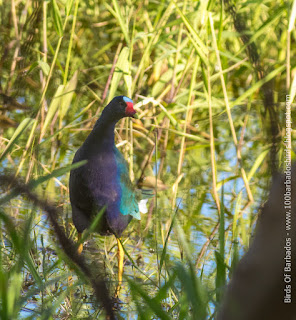 |
| Pied-billed Grebe - one of the waterbird species @ Walkers Reserve |
The whole world is at a standstill because of the COVID pandemic. Traveling between countries has all but ceased as many countries are closing borders. Not everyone was affected, or should I say not everything, because there are a few thousand nomads whose sojourn across the globe has continued unabated. Using ancient highways in the sky, virtually unnoticed by the masses, except for a few who made it their business to notice, to document, and to find ways to assist these travelers.
Of course, the travelers we are speaking of are birds, migratory birds. While these continue to travel from their breeding grounds to feeding grounds and back unaffected by the pandemic, for years their numbers have continued to decline, and none more so than that of waterbirds. Waterbirds refer to birds that live on or around water, especially freshwater. This includes shorebirds, ducks, herons, and egrets, to mention a few. This family of migrating birds continue to suffer from the effects of climate change and loss of habitat. To truly understand the impact and be able to provide targeted and effective solutions, data is needed. Accurate data is the foundation of good decision-making and in our part of the world, many tools are being used to collect data. One such tool is the Caribbean Waterbird Census (CWC). This “multi-partner region-wide waterbird and wetland monitoring program [is] led by Birds Caribbean”, whose mandate among other things is to conserve “bird populations and [their] ecosystems.”
 |
| John all geared up for the count |
The birders of Barbados were happy to be part of the 2020/21 survey. Dr. John Webster and I were involved in surveying several targeted sites across the island between August 15 to October 15, 2020, the peak fall migration period, and from January 14 to February 3, 2021. We visited these sites on multiple occasions recording the birds seen there and the quality of the site - (water levels, vegetation, food availability, or anything that could impact the birds stopping, resting, or feeding there). We also recorded such things as, the time of day we visited, the temperature, weather conditions, wind direction, and intensity. This created a snap shot of each visit and in time would be able to highlight any trends. This got us out in the field and visiting these locations more often than we normally would.
 |
| American Coot family at Walkers Reserve, St. Andrew |
 |
| The Ruff seen at WSR during the CWC |
A Ruff (Calidris pugnax) at Woodbourne Shorebird Refuge (WSR) was also a good find. This Eurasia vagrant was seen on October 10th, 2020.
Barbados,
because of its isolated location in the Atlantic is an important link in the
yearly migratory route of many birds. How much so and how can we assist
in making the travels of these regional and international nomads safer?
The data collected by programs like the CWC could help provide the answers.
We look forward to future CWC events, with the hope of expanding to other
sites and eventually getting more persons involved as we seek to create a safe
path for the Birds of Barbados, the region, and the world.
Notables and images from the CWC
location: Chancery Lane Swamp, Christ Church- 31 Whimbrels (Numenius phaeopus) - September 7th
- 3 Willets (Tringa semipalmata) - August 24th
- 25 American Golden - Plover (Pluvialis dominica) - September 22nd
- 21 Lesser Scaup (Aythya affinis) - January
- 4 species of ducks -
- Blue-winged Teal (Spatula discors)
- American Wigeon - (Mareca americana)
- Ring-necked Duck (Aythya collaris)
- Lesser Scaup (Aythya affinis)
 |
| A fraction of the 31 Whimbrels |
 |
| Lesser Scaups in January |
Location: Woodbourne Shorebird Refuge
 |
| Lesser Scaup |
- Ruff (Calidris pugnax) -October 10th, 2020
- 5 species of ducks in January:
- Black-bellied Whistling-Duck(Dendrocygna autumnalis) with Ducklings
- Blue-winged Teal (Spatula discors)
- Green-winged Teal (Anas crecca)
- Ring-necked Duck (Aythya collaris)
- Lesser Scaup (Aythya affinis)
- 2 Buff-breasted Sandpiper (Calidris subruficollis) October
- Collared Plover (Charadrius collaris)
- 111 Semipalmated Sandpiper (Calidris pusilla) September 16th
- 17 species of shorebirds
 |
| Least Sandpiper |
Location Walkers Reserve, St. Andrew
- 2 pairs of American Coots (Fulica americana)(white shielded) with a total of three chicks and one bird building a nest.





